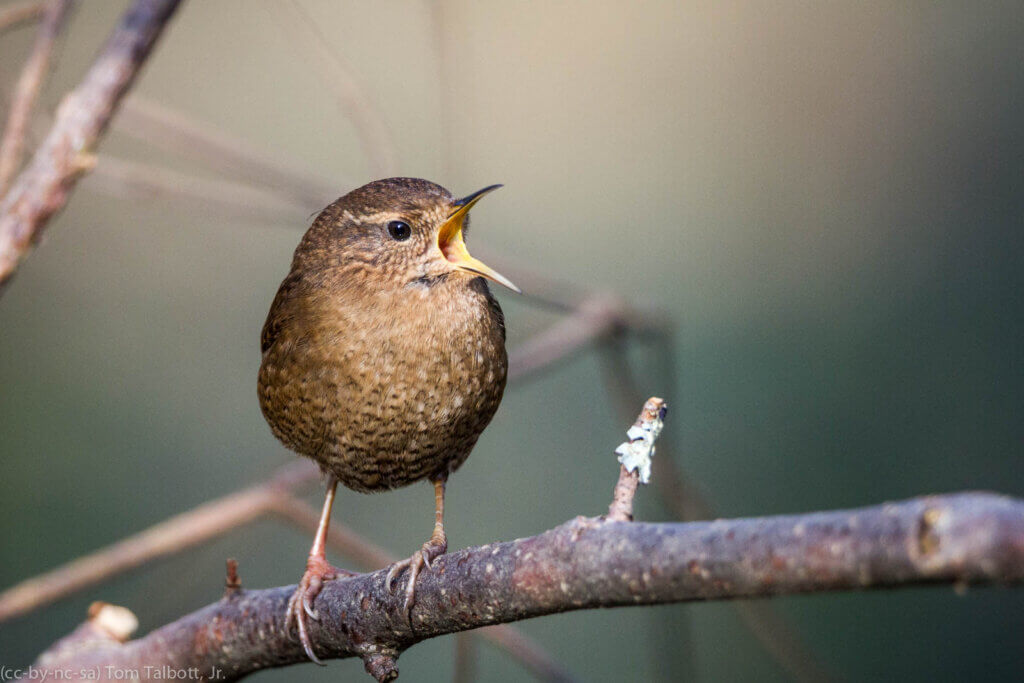The Mighty Wren
By Tami Brunk
Broadcast 4.2003, 5.2015, 4.5 & 4.8.2023

Pacific Wren singing away! Photo by Tom Talbott, Jr., CC BY-NC-SA 4.0.
Listen:
I was sunning myself on a large boulder along the snowy banks of the Lochsa River, absorbing warmth and the scent of red cedar, when an abrupt call: “check! check! check!” startled me out of my reverie. I turned to glimpse a tiny, dark brown animal disappearing into a rotted log. Moments later, it resurfaced, hopped merrily up onto the crumbling red wood, and began scratching and poking about for its dinner.
I grinned when I realized that my just-arrived companion was a Pacific Wren. I’d become familiar with this species when I worked a summer in the old-growth Douglas-fir forests of Mount Rainier National Park. Their vibrant, multilayered calls were a highlight of my daily walks, and I marveled that this tiny creature could make such a ruckus. A little research revealed that, despite its miniature size, both science and folklore pay tribute to the wren’s bold spirit and varied and dynamic song.
The Pacific Wren has only been recognized as a distinct species since 2010. When I saw these birds years ago in Mount Rainier National Park, they were considered to be the same species as the Winter Wren, of the subspecies pacifica. Based on a deeper study of their genetics and vocalizations, however, Winter Wrens were divided into three distinct species: Eurasian Wrens, found in Europe, Asia, and parts of North Africa; Winter Wrens, found in eastern North America; and Pacific Wrens, like the one I saw, found in western North America.
The Pacific Wren frequents mature and old-growth forests of the Pacific Northwest. Weighing 9 grams on average, with a length of about three and a half inches, and colored a deep rich brown, it is easily mistaken, on first glance, for a mouse. This perception is furthered when the observer sees it hopping and scurrying along the forest floor, over fallen trees, and under stream banks. It spends much of its time on or near the ground, searching for its favorite prey—beetles and spiders.
Across cultures, stories of the wren’s boldness abound. In one African-American folktale, the clever wren wins a challenge to see which bird can fly the highest—by hiding on the back of an eagle—then hopping off and soaring above it when the eagle becomes exhausted. In an Appalachian folktale, a father wren returns to the nest to find that his babies had been nearly “skeert to death” by a panther. He quickly overtakes the panther, and warns him that if he messes with his family again, he will crush him with his little foot.
The wren’s bold reputation is based in part on the terrific volume of its song. Per unit of weight, the wren’s song is ten times louder than that of a rooster! Its song, particularly that of the Pacific Wren, is also marvelously varied. In an Oregon study, a male wren was recorded to have performed 66 different song types; as compared to the male Winter Wren, who performs only three. Male wrens are fiercely territorial, and much of their singing is a warning for rivals to stay out! If the rival does approach, a dramatic confrontation may occur, with each male cocking its tail, quivering its wings and feathers, and even snapping at the other, until one is sufficiently intimidated to leave.
What occurs to me today as I consider the indomitable wren is that its boldness has, up to this point, been no match for the biggest present-day threat to its existence. As its preferred old-growth habitat continues to be fragmented, its numbers are declining. In a study conducted in Northern California, for example, populations were shown to have declined by 47 percent from historic numbers. While they can exist in mature forests, wrens are two times more likely to be found in old growth. At this point in history, the mighty wren may finally need the help of another species—Homo sapiens—in order to continue its existence in the forests of the American West.
Every week since 1991, Field Notes has inquired about Montana’s natural history. Field Notes are written by naturalists, students, and listeners about the puzzle-tree bark, eagle talons, woolly aphids, and giant puffballs of Western, Central and Southwestern Montana and aired weekly on Montana Public Radio.
Click here to read and listen to more Field Notes. Field Notes is available as a podcast! Subscribe on Apple Podcasts or wherever you listen to podcasts.
Interested in writing a Field Note? Contact Allison De Jong, Field Notes editor, at adejong [at] montananaturalist [dot] org or 406.327.0405.
Want to learn more about our programs as well as fun natural history facts and seasonal phenology? Sign up for our e-newsletter! You can also become a member and get discounts on our programs as well as free reciprocal admission to 300+ science centers in North America!












